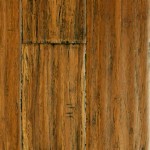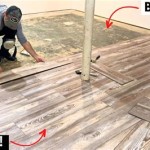Vinyl Slate Flooring: A Comprehensive Guide
Vinyl slate flooring has emerged as a popular choice for homeowners and businesses seeking a cost-effective and aesthetically pleasing alternative to natural slate. This material replicates the appearance of genuine slate while offering enhanced durability, easier maintenance, and a significantly lower price point. Understanding the properties, benefits, installation processes, and maintenance requirements of vinyl slate flooring is crucial for making an informed decision about its suitability for a particular space.
Vinyl flooring, in general, is a synthetic material composed primarily of polyvinyl chloride (PVC). This polymer provides water resistance and flexibility, making it ideal for flooring applications. Vinyl slate flooring specifically is designed with a textured surface and printed patterns that mimic the look and feel of natural slate. This includes variations in color, texture, and even the subtle imperfections found in quarried stone.
The construction of vinyl slate flooring typically involves multiple layers. The base layer provides stability and contributes to the floor's structural integrity. Above that is a printed layer displaying the slate pattern. This layer is often protected by a clear wear layer, which is crucial for resisting scratches, scuffs, and stains. The thickness of the wear layer directly impacts the flooring's durability and its suitability for high-traffic areas.
There are two main types of vinyl slate flooring available: sheet vinyl and vinyl tiles/planks. Sheet vinyl comes in large rolls, providing a seamless installation. This is particularly advantageous in areas prone to moisture, such as bathrooms and kitchens, as it minimizes the risk of water seeping through seams. Vinyl tiles and planks, on the other hand, are individual pieces that are installed separately. They offer more design flexibility and allow for easier replacement of damaged sections.
Key Advantages of Vinyl Slate Flooring
Vinyl slate flooring offers a variety of advantages over natural slate and other flooring options. These advantages contribute to its growing popularity in both residential and commercial settings.
First and foremost is its cost-effectiveness. Natural slate is a premium material, and its price reflects the labor and resources required for quarrying, cutting, and transporting it. Vinyl slate flooring, being a synthetic material, is significantly less expensive, making it an accessible option for those on a budget. This cost advantage extends beyond the initial purchase price; the installation costs are also typically lower than those associated with natural slate.
Another significant benefit is its durability and water resistance. Vinyl is naturally resistant to water, making it an ideal choice for areas prone to moisture, such as bathrooms, kitchens, and basements. Unlike natural slate, which can be porous and susceptible to staining and water damage, vinyl slate flooring is relatively impervious to these issues. The wear layer provides further protection against scratches, scuffs, and stains, ensuring that the floor retains its appearance for an extended period.
Ease of maintenance is also a key advantage. Vinyl slate flooring requires minimal upkeep. Regular sweeping or vacuuming is sufficient to remove loose dirt and debris. For more thorough cleaning, a damp mop with a mild detergent can be used. Unlike natural slate, which may require specialized cleaning products and sealing, vinyl slate flooring is relatively easy to clean and maintain, saving time and effort.
Installation Considerations for Vinyl Slate Flooring
The installation process for vinyl slate flooring varies depending on the type of flooring chosen – sheet vinyl or vinyl tiles/planks. Regardless of the type, proper preparation is essential for a successful installation.
The subfloor must be clean, level, and dry. Any imperfections in the subfloor, such as cracks, bumps, or unevenness, must be addressed before installing the vinyl flooring. This may involve patching cracks, sanding down bumps, or applying a leveling compound. A smooth and even subfloor ensures that the vinyl flooring lies flat and does not develop any unsightly bumps or depressions over time.
For sheet vinyl installation, professional installation is often recommended due to the large size and weight of the material. The sheet vinyl is typically glued down to the subfloor using a specialized adhesive. Careful cutting and fitting are required to ensure a seamless installation, particularly around corners and edges.
Vinyl tiles and planks, on the other hand, can be installed using either a glue-down or a click-lock system. Glue-down tiles are adhered to the subfloor using an adhesive, while click-lock tiles have interlocking edges that allow them to be snapped together without the need for glue. Click-lock systems are generally easier to install for DIYers, as they require less specialized tools and expertise.
Regardless of the installation method, it is important to follow the manufacturer's instructions carefully. This includes using the correct adhesive, allowing for proper acclimation of the flooring to the room's temperature and humidity, and ensuring that the tiles or planks are properly aligned.
It's noteworthy to consider the use of an underlayment beneath the vinyl flooring. Underlayment can provide added cushioning, sound insulation, and thermal insulation. It can also help to conceal minor imperfections in the subfloor and improve the overall comfort of the floor.
Maintaining the Appearance and Longevity of Vinyl Slate Flooring
While vinyl slate flooring is relatively easy to maintain, following proper cleaning and maintenance procedures is essential for preserving its appearance and extending its lifespan.
Regular sweeping or vacuuming is crucial for removing loose dirt and debris. This prevents the accumulation of abrasive particles that can scratch the surface of the flooring. It is important to use a vacuum cleaner with a soft brush attachment to avoid damaging the wear layer.
For more thorough cleaning, a damp mop with a mild detergent can be used. Avoid using harsh chemicals, abrasive cleaners, or scouring pads, as these can damage the surface of the flooring. Always follow the manufacturer's recommendations for cleaning products and procedures.
To prevent scratches and scuffs, it is recommended to use furniture pads under the legs of chairs, tables, and other heavy objects. This helps to distribute the weight more evenly and reduces the risk of damage to the flooring. It is also advisable to avoid dragging heavy objects across the floor.
In high-traffic areas, consider using mats or rugs to protect the flooring from excessive wear and tear. These mats can trap dirt and debris before they are tracked onto the floor, reducing the need for frequent cleaning.
While vinyl slate flooring is water-resistant, it is still important to clean up spills promptly. This prevents the risk of staining or water damage. Use a clean, absorbent cloth to blot up the spill, and then clean the area with a damp mop and mild detergent.
Over time, the wear layer of vinyl slate flooring may become worn or scratched. In such cases, it may be possible to apply a sealant or polish to restore the flooring's appearance and protect it from further damage. Consult with a flooring professional for recommendations on suitable sealants and polishes.
The choice of vinyl slate flooring represents a balance between cost-effectiveness, aesthetic appeal, and practical considerations. Understanding its material composition, installation process, and maintenance requirements allows informed decision-making to satisfy specific needs and preferences. The benefits of mimicking the appearance of natural slate at a more affordable price, coupled with ease of maintenance and durability, position vinyl slate flooring as a compelling option in a variety of settings.
The variations in color, texture, and pattern available in vinyl slate flooring contribute to its versatility. It can be used to create a wide range of styles, from rustic and traditional to modern and contemporary. The ability to customize the look of the floor makes it an appealing choice for homeowners and businesses seeking to create a unique and inviting space.
Ultimately, the suitability of vinyl slate flooring depends on individual needs and priorities. Consider factors such as budget, traffic levels, moisture exposure, and aesthetic preferences when making a decision. While vinyl slate flooring may not offer the same level of prestige and natural beauty as genuine slate, it provides a practical and affordable alternative that can enhance the appearance and functionality of a space.

Lifeproof Overlook Slate 22 Mil X 18 5 In W 37 L Lock Waterproof Vinyl Tile Flooring 19 1 Sq Ft Case Sl584102 The Home Depot

Coreluxe 6 5mm W Pad Smithsonian Slate Waterproof Rigid Vinyl Tile Flooring 12 In Wide X 24 Long Ll

Vinyl Flooring Rubens Riven Slate Designflooring Indoor Residential Tile

Ecostep Urban Slate 909e Vinyl Cushion Floor

Lifeproof Castle Black Slate 6 Mil X 12 In W 24 L Lock Waterproof Vinyl Tile Flooring 23 8 Sqft Case I584102l The Home Depot

Cushion Vinyl Flooring Mannington Slate Majesty Surrey Carpet Centre Factory Direct

Slate Tile Stone Effect Self Adhesive Vinyl Pack Of 13 Tradepoint

Tile With Igt Collection Luxury Vinyl Flooring In Slate Copper Trucor

Newage S Slate Gray 27 6 Mil X 12 In W 24 L Waterproof Interlocking Luxury Vinyl Tile Flooring 13 44 Sq Ft Pallet The Department At Com
Luxury Vinyl Tile Cuarzo Or Quartz Stone
Related Posts








